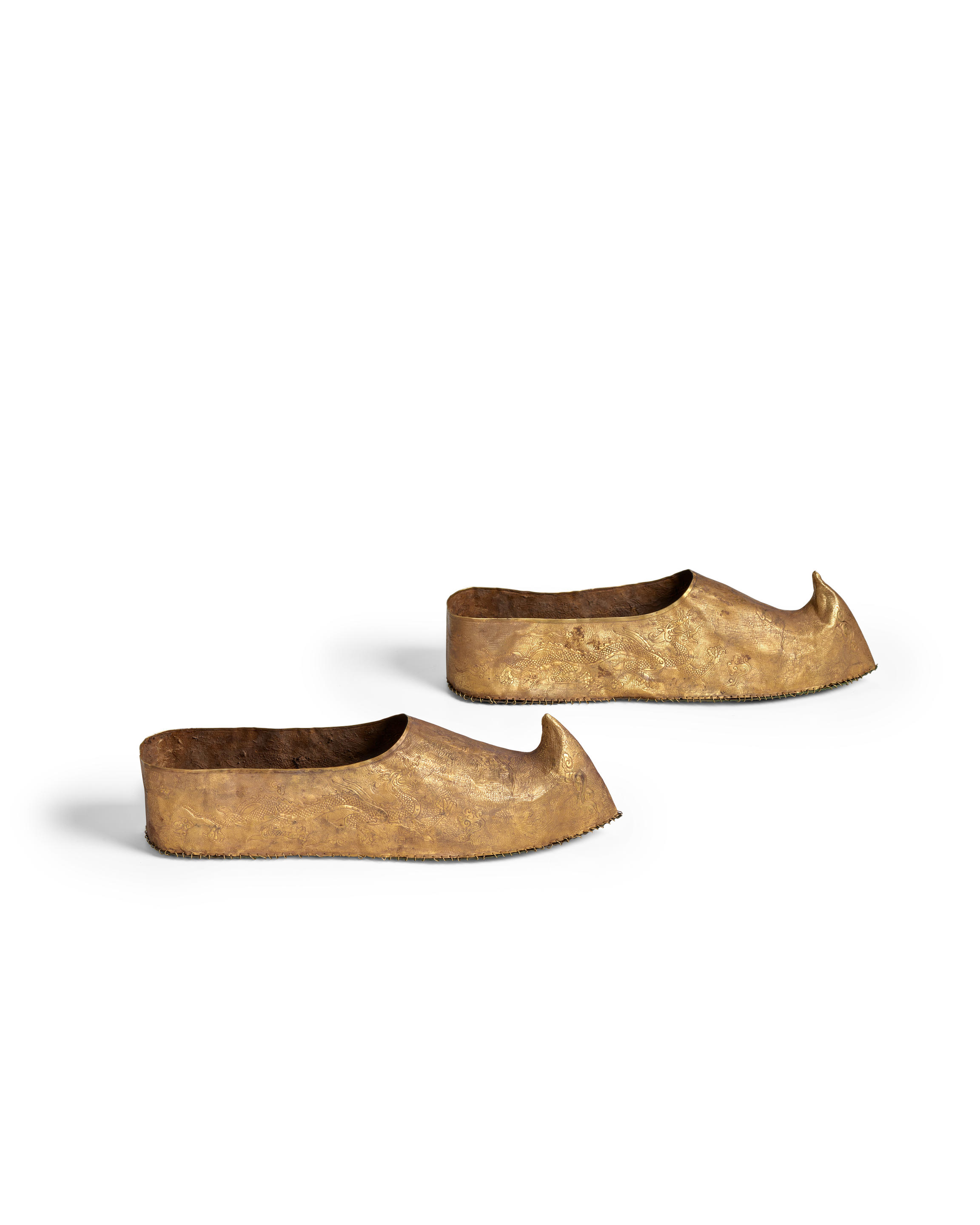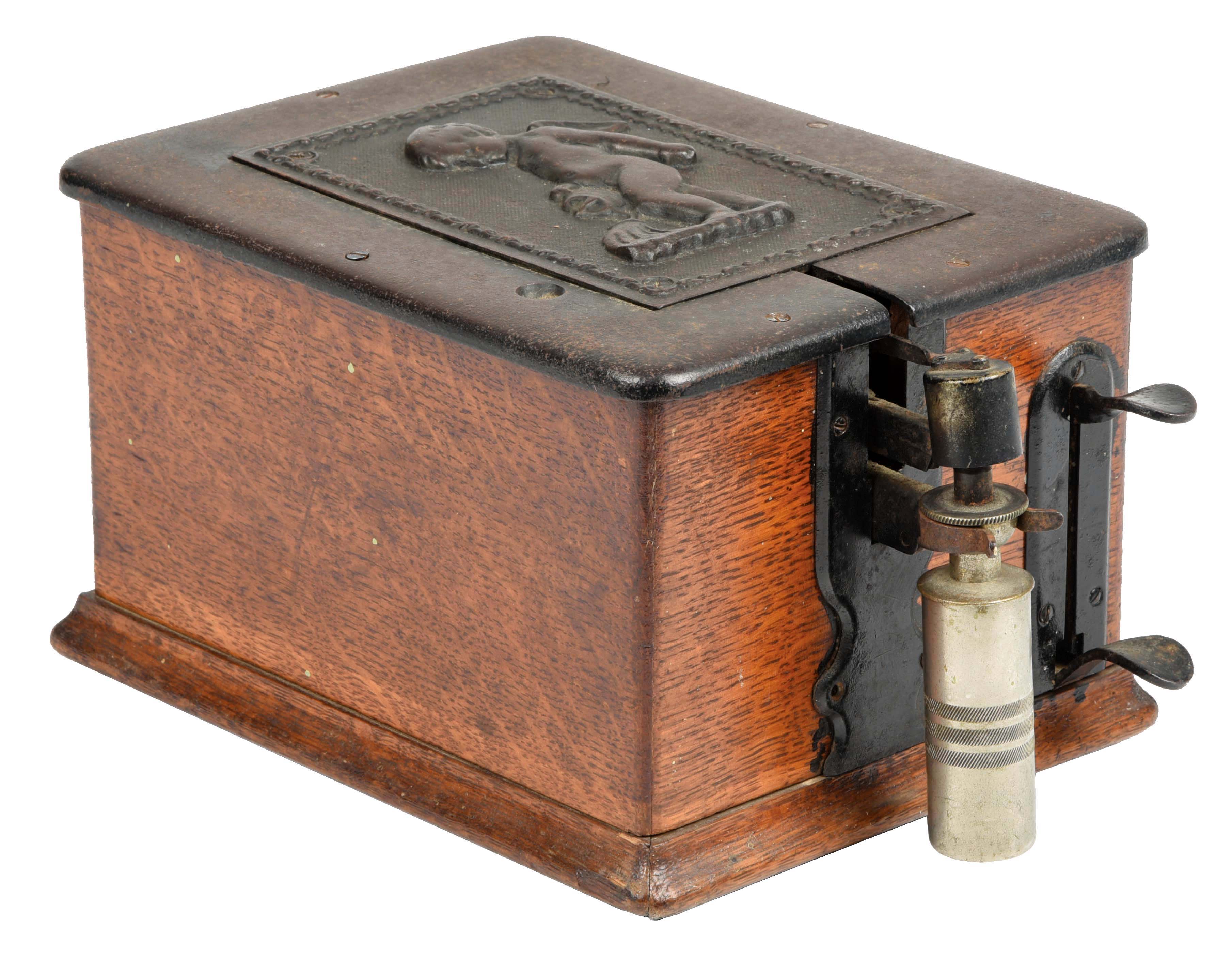A rare and unusual ceremonial rock crystal and gold mounted staff of office or tipstaff, first half of the 19th century, of possible historical importance, the ivory shaft topped with a rock crystal sphere, beneath gold crown surmount, and engraved below with a crowned lion passant upon a crown, the sphere ‘sling’ mounted within four hinged vertical strapwork fittings, (one strap missing, one detached at the base), the tapering shaft encircled by bands of gold repeating detail, the knop applied with a cap of finely cast gold overlapping leaves and four ‘Tudor’ rose highlights, with ball finial detail below, unmarked, length 26.5cm, diameter of rock crystal sphere approximately 4.7cm. £5,000-£7,000 Condition Report The mounts have been tested as gold. The shaft mounts do not unscrew so there is no vacant compartment inside. One of the vertical straps containing the globe is missing altogether, another is detached at the base, so the sphere is loose. Some slight vertical splitting to the ivory shaft - the ivory is not elephant, probably walrus ivory. Gross weight 282gm. Footnote The use of fine gold mounts, together with the engraved ‘crowned lion on crown’, (which is consistent with the style of engraving used on coinage during the reign of George IV) would suggest a possible Royal association for this staff of office. One theory is that this piece may have connections with the Coronation of King George IV on 19th July 1821. This was an extremely lavish and fabulously expensive occasion (the total cost of the event was reported to be in the region of £243,000 - equivalent to £22 million today). Dignitaries and courtiers who attended the service processed in their fine robes, and carrying their staves of office on entry to Westminster Abbey. A series of detailed watercolours were painted of this procession by Sir George Nayler in 1823, later bound as a folio volume in 1837 (The Coronation of His Most Sacred Majesty King George IV) - in these paintings many of the guests are depicted carrying decorative staves of office. In August 1822, following the coronation, George IV undertook a Royal state visit to Scotland (the first royal visit of a reigning sovereign since King Charles II in 1651). The visit, organised by Sir Walter Scott commenced on Monday 11th August, with the King’s arrival at Leith. The Honours of Scotland - the Scottish crown jewels, had been recently rediscovered in 1818; they had been stored in a great oak chest in the stone vaulted Crown Room of Edinburgh castle, hidden there since the Treaty of Union in 1707, and unseen for over 200 years. The King’s visit culminated in a grand procession to restore the Honours to the Castle; contemporary paintings again illustrate the vast scale and expense of these events, with guests sumptuously and richly attired, bearing appropriate staves of office. Beliefs in the talismanic and prophetic powers of ‘magic’ crystals dates back to the ancient world, with Roman historian Pliny recording the supernatural powers of quartz crystal. Rock crystal in particular is recorded as having ‘occult powers’, with known examples of prized crystals dating back to the Viking and pre-Christian periods. To quote jewellery historian Geoffrey Munn in an article on this subject: “It seems likely that ownership of crystal balls in precious metal mounts was for an elite and, in common with jewellery of all kinds, they were a powerful status symbol, even a mark of sovereignty. The sceptre of the Scottish Regalia, for example, is set with a fine specimen at it’s head”. References to the magical powers of crystal balls appears to be widespread in history, but particularly in Scotland. The Scots even took magic crystals into battle in the hope that they would ensure victory. Examples of early crystal globes show mountings within a ‘sling’ of precious metal strips, joined to decorative mounts at the north and south ‘poles’ of the stones. Geoffrey Munn explains that “these mounts must be closed mechanica
A rare and unusual ceremonial rock crystal and gold mounted staff of office or tipstaff, first half of the 19th century, of possible historical importance, the ivory shaft topped with a rock crystal sphere, beneath gold crown surmount, and engraved below with a crowned lion passant upon a crown, the sphere ‘sling’ mounted within four hinged vertical strapwork fittings, (one strap missing, one detached at the base), the tapering shaft encircled by bands of gold repeating detail, the knop applied with a cap of finely cast gold overlapping leaves and four ‘Tudor’ rose highlights, with ball finial detail below, unmarked, length 26.5cm, diameter of rock crystal sphere approximately 4.7cm. £5,000-£7,000 Condition Report The mounts have been tested as gold. The shaft mounts do not unscrew so there is no vacant compartment inside. One of the vertical straps containing the globe is missing altogether, another is detached at the base, so the sphere is loose. Some slight vertical splitting to the ivory shaft - the ivory is not elephant, probably walrus ivory. Gross weight 282gm. Footnote The use of fine gold mounts, together with the engraved ‘crowned lion on crown’, (which is consistent with the style of engraving used on coinage during the reign of George IV) would suggest a possible Royal association for this staff of office. One theory is that this piece may have connections with the Coronation of King George IV on 19th July 1821. This was an extremely lavish and fabulously expensive occasion (the total cost of the event was reported to be in the region of £243,000 - equivalent to £22 million today). Dignitaries and courtiers who attended the service processed in their fine robes, and carrying their staves of office on entry to Westminster Abbey. A series of detailed watercolours were painted of this procession by Sir George Nayler in 1823, later bound as a folio volume in 1837 (The Coronation of His Most Sacred Majesty King George IV) - in these paintings many of the guests are depicted carrying decorative staves of office. In August 1822, following the coronation, George IV undertook a Royal state visit to Scotland (the first royal visit of a reigning sovereign since King Charles II in 1651). The visit, organised by Sir Walter Scott commenced on Monday 11th August, with the King’s arrival at Leith. The Honours of Scotland - the Scottish crown jewels, had been recently rediscovered in 1818; they had been stored in a great oak chest in the stone vaulted Crown Room of Edinburgh castle, hidden there since the Treaty of Union in 1707, and unseen for over 200 years. The King’s visit culminated in a grand procession to restore the Honours to the Castle; contemporary paintings again illustrate the vast scale and expense of these events, with guests sumptuously and richly attired, bearing appropriate staves of office. Beliefs in the talismanic and prophetic powers of ‘magic’ crystals dates back to the ancient world, with Roman historian Pliny recording the supernatural powers of quartz crystal. Rock crystal in particular is recorded as having ‘occult powers’, with known examples of prized crystals dating back to the Viking and pre-Christian periods. To quote jewellery historian Geoffrey Munn in an article on this subject: “It seems likely that ownership of crystal balls in precious metal mounts was for an elite and, in common with jewellery of all kinds, they were a powerful status symbol, even a mark of sovereignty. The sceptre of the Scottish Regalia, for example, is set with a fine specimen at it’s head”. References to the magical powers of crystal balls appears to be widespread in history, but particularly in Scotland. The Scots even took magic crystals into battle in the hope that they would ensure victory. Examples of early crystal globes show mountings within a ‘sling’ of precious metal strips, joined to decorative mounts at the north and south ‘poles’ of the stones. Geoffrey Munn explains that “these mounts must be closed mechanica















Testen Sie LotSearch und seine Premium-Features 7 Tage - ohne Kosten!
Lassen Sie sich automatisch über neue Objekte in kommenden Auktionen benachrichtigen.
Suchauftrag anlegen